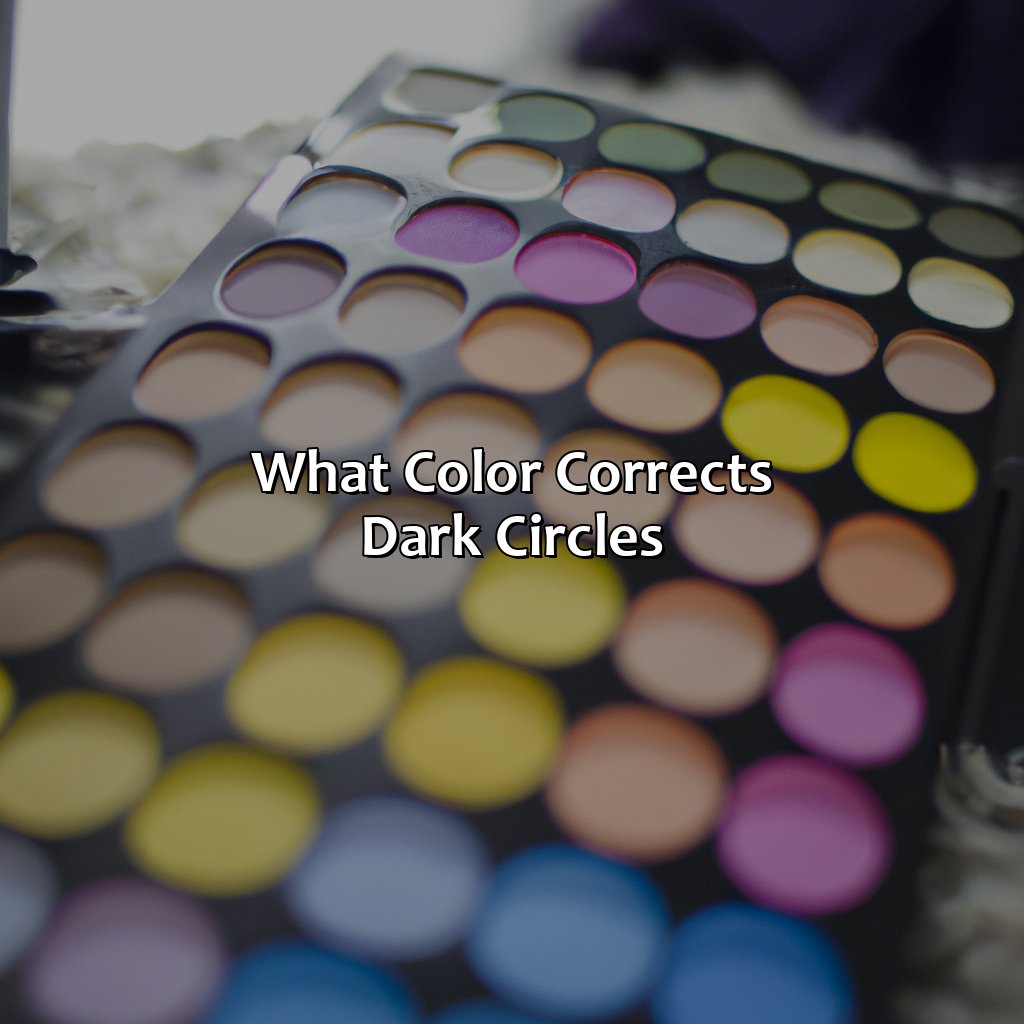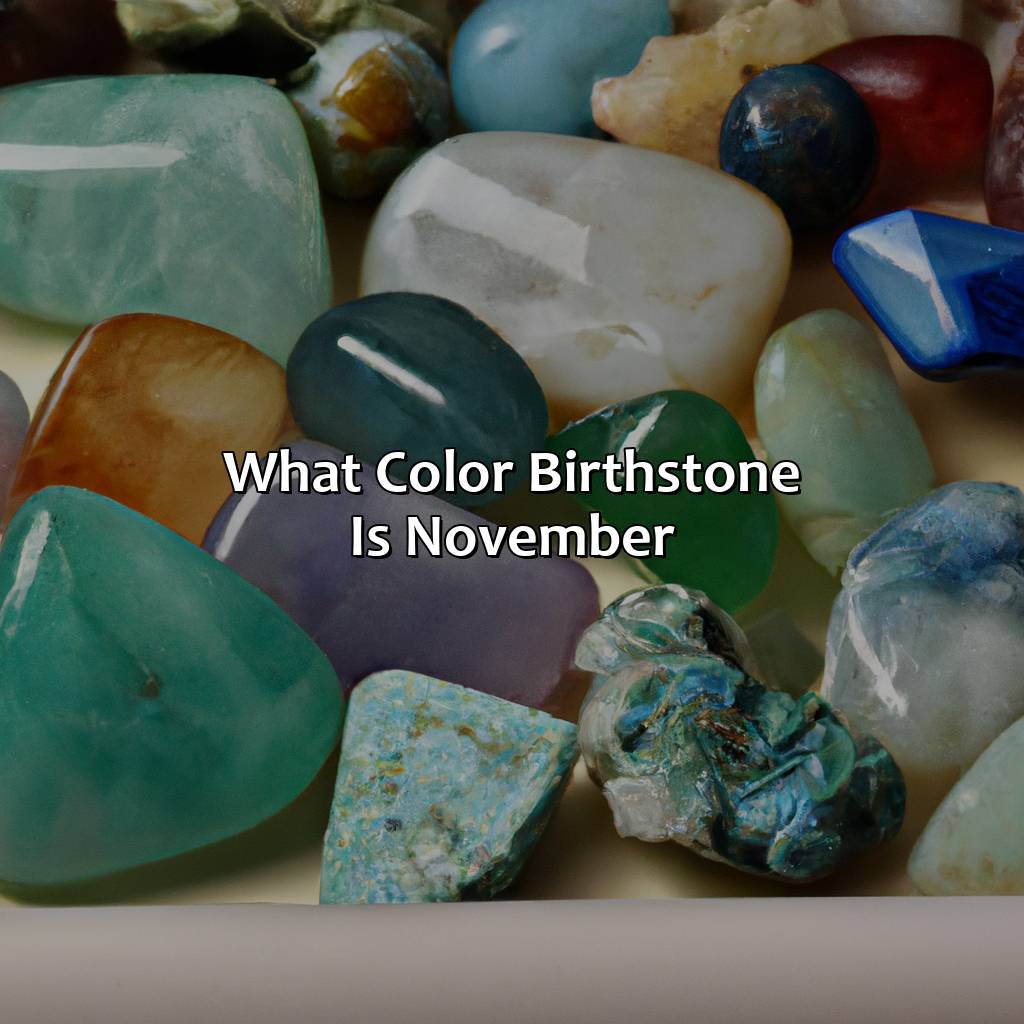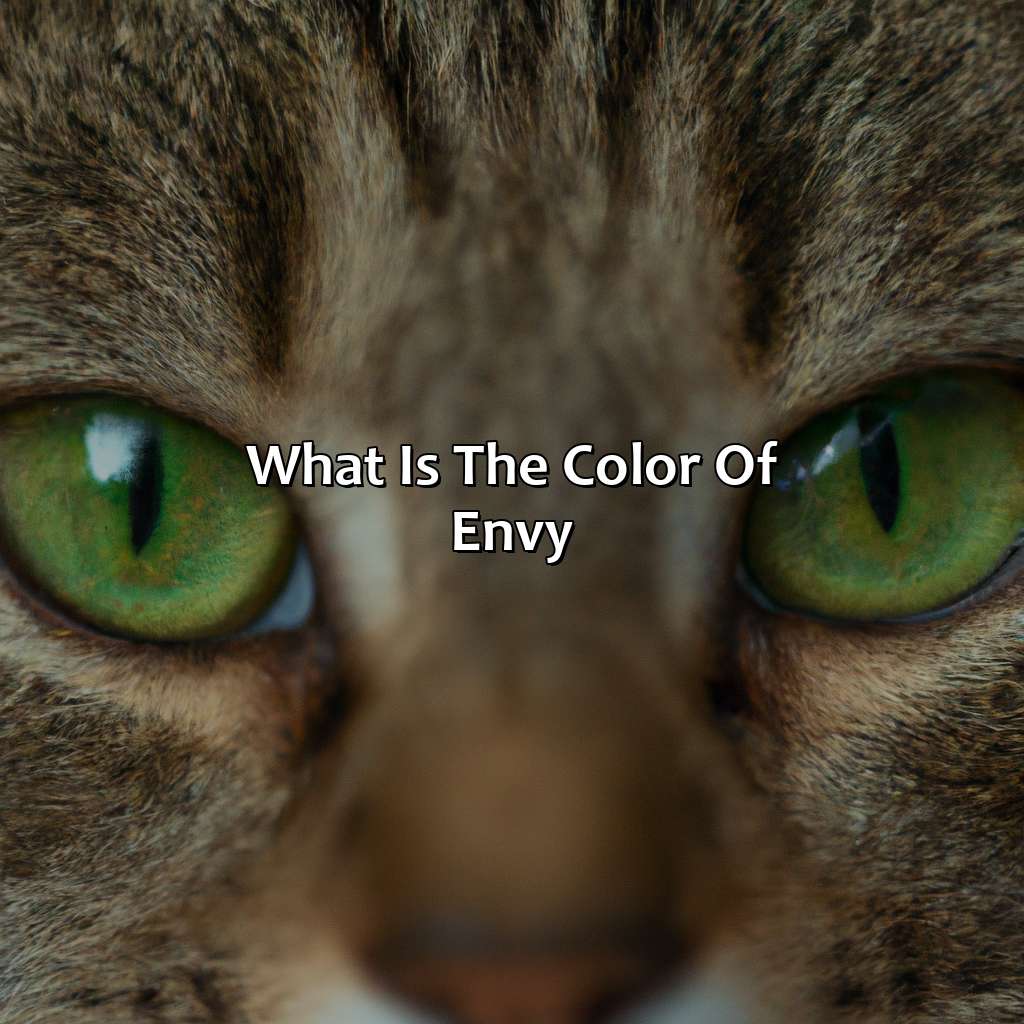Key Takeaway:
- Understanding dark circles: Dark circles can be caused by various factors, such as lack of sleep, pigmentation, and discoloration. It is important to identify the underlying cause before choosing a color corrector.
- Colors that correct dark circles: Different colors can be used to correct different underlying issues, according to color theory. The most common correctors for dark circles are peach, orange, yellow, and lavender.
- Application techniques: Color correctors can be applied with a brush, sponge, or fingers, depending on personal preference. It is recommended to start with a small amount and blend well before layering with concealer.
Understanding Dark Circles

Photo Credits: colorscombo.com by Raymond Jackson
Dark circles refer to the discoloration around the eyes that can make you look tired and aged. They can be caused by various factors, including genetics, age, poor sleep, dry skin, allergies, or sun damage. Understanding the causes and types of dark circles is vital to finding the right solution.
Dark circles can be classified based on their color and depth. Blue or purple circles are caused by the pooling of oxygen-poor blood under the eyes, while brown or grey circles are due to hyperpigmentation or thinning of the skin. Green correctors are suitable for neutralizing redness, while peach or salmon shades work well in canceling out blue or purple hues.
Apart from using color correctors, there are other ways to reduce dark circles, such as using eye creams with retinol or caffeine, applying cold compresses, getting enough sleep, staying hydrated, and avoiding allergens. Additionally, it’s essential to choose beauty products and cosmetics that match your complexion and skin tone to achieve a flawless look.
Did you know that the skin around our eyes is 10 times thinner than the rest of the face? According to dermatologists, this delicate area is prone to wrinkles, fine lines, and dark circles, making it essential to use gentle and nourishing skincare products.
Colors that Correct Dark Circles
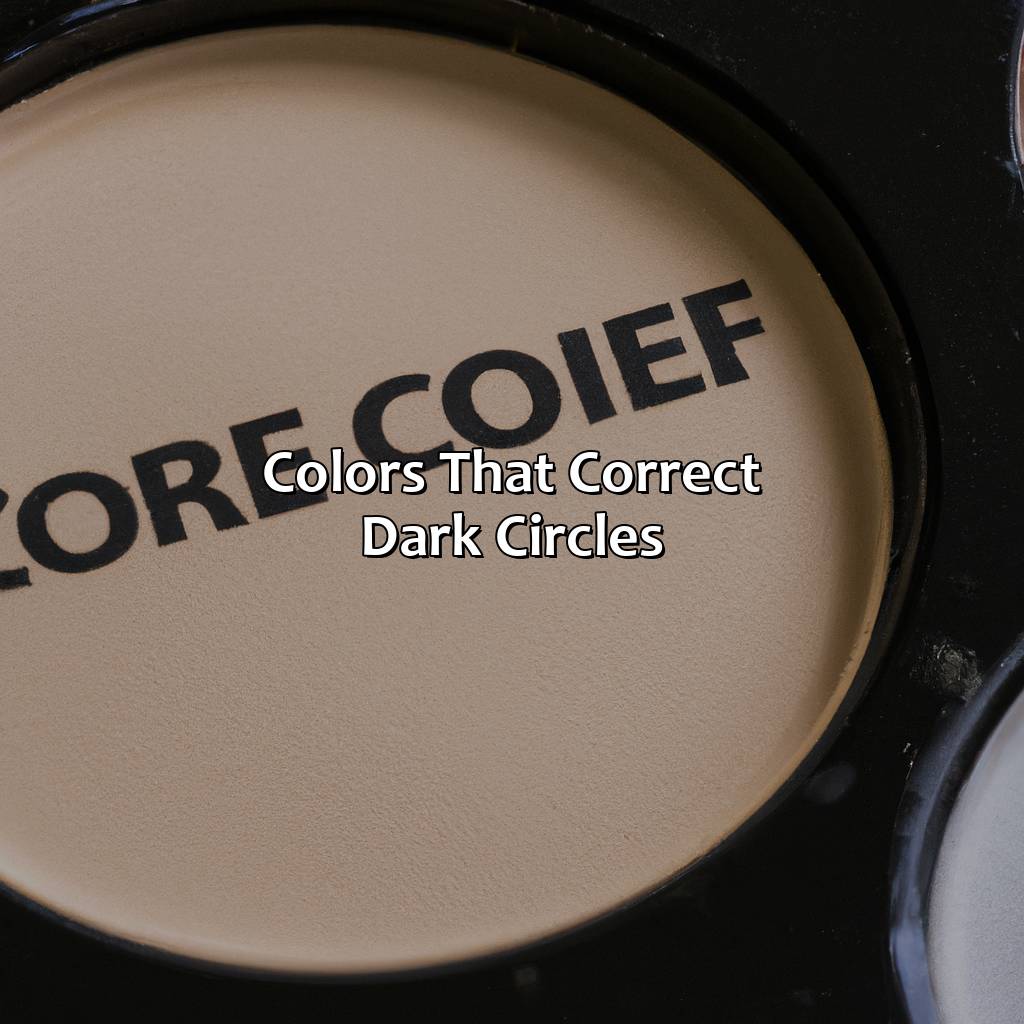
Photo Credits: colorscombo.com by Christian Torres
To fix dark circles with makeup, color theory is key. To find which color corrector suits your skin tone and discoloration, consider the following:
- Peach for dull skin with blue undertones.
- Orange for darker skin tones and severe dark circles.
- Yellow for bluish-purple bags or mild dark circles.
- Pink for brightening and evening out skin tone.
- Red for green or brown discoloration.
- Purple/Lavender for yellow or sallow skin tones.
- Green for correcting redness or acne scars.
Peach
To correct dark circles, the peach corrector is an ideal choice. Using color theory, it neutralizes blue and purple hues of dark circles that are common among all skin tones and undertones. This shade works perfectly on those who have a fair to medium complexion with peach undertones.
To use peach correctly, first cleanse your face and apply moisturizer. Then take the peach corrector on your finger or brush and blend it under your eyes till you get the desired coverage. For best results, combine it with a concealer that matches your skin tone.
Apart from the color correcting palette, one can also choose to use a single-color corrector like peach for convenience.
Don’t forget that every individual’s skin tone is unique, so a color correcting shade should be chosen accordingly. Use appropriate shades based on skin tone as well.
Incorporating regular lifestyle changes like healthy eating habits, having enough sleep, managing stress levels would help in reducing dark circles in the long run.
Want to get rid of dark circles once and for all? Try professional treatments such as chemical peels that remove dead skin cells or laser therapy that promote collagen production.
Get ready to flaunt your flawless complexion by using the right shades of color correctors on targeted areas!Put on some orange concealer and bam! Your dark circles will disappear like magic, or your money back (just kidding, we don’t offer that kind of guarantee).
Orange
The orange shade is a great color correcting option for under-eye dark circles. It helps to neutralize blue and purple undertones in the skin, making it perfect for those with fair to medium skin tones. Using an orange concealer before applying your regular concealer and makeup can give you a flawless finish.
When choosing an orange correcting product, you may choose between a cream-based or a liquid formula. The cream-based option works best for dry or mature skin types, while the liquid formula is perfect for oily or combination skin types.
To apply the product effectively, use a small amount of the product on your ring finger and pat it onto the area. Make sure to blend it evenly and gently into the skin to avoid any streaks. Then apply your regular concealer over its top style as desired.
Pro Tip: Blend well with other colors in the same range to achieve natural-looking results.
Remember that color correction alone may not completely resolve under-eye darkness. However, incorporating this method along with proper skincare routine and lifestyle changes can significantly impact how well your concealer covers those pesky dark circles.
Transform your dark under eye bags to a sunny disposition with the power of yellow corrector and color theory for a flawlessly radiant complexion.
Yellow
As per color theory, yellow corrector is an effective way to counteract dark circles with purple or blue undertones. It suits well for people with medium to dark complexion. Applying a yellow corrector underneath your concealer can help you achieve a more even complexion while hiding pesky under-eye bags.
Pairing yellow with other colors in a color-correcting palette may also work wonders. For instance, mixing peach and yellow tones can help with brightening up the under-eye area.
For unique effects, color-correcting primers and products infused with brightening ingredients like vitamin C can provide extra illumination while diminishing any dark spots.
As a result of anecdotal evidence, users who continually experience this problem suggest that using both eye creams and hydrating masks on afflicted under-eyes helps them wake up feeling refreshed!
Who knew that the solution to looking less like a zombie and more like a human was just a little bit of pink makeup?
Pink
To apply pink color corrector, use a small brush to blend it into the area under the eye. Start from the inner corner and work your way outward. Use only a tiny amount of product, as this color correcting shade can look too vibrant if over-applied. Follow up with a concealer that matches your skin tone for best results.
In addition to using pink color correction makeup, incorporating an eye cream into your skincare routine can help address pigmentation and discoloration of the under-eye area. Look for ingredients like vitamin C and caffeine that can help brighten and improve the overall appearance of dark circles.
True Fact: The use of color correction in makeup has become increasingly popular in recent years due to its ability to address various skin concerns, including dark circles. (Source: Allure)
Red is not just a bold lip color, it’s also a great tool for correcting pigmentation and discoloration under your eyes with concealer.
Red
Color Correction: Red
Red color corrector is perfect for dark circles with purple and blue tones. It cancels out the shadows with its complementary shade and creates an even base for concealer. Red pigmentation can also cause under-eye discoloration, making this color correcting option a great choice.
For an instant under-eye pick-me-up, apply a thin layer of red color corrector before your regular concealer. This will neutralize any darkness under the eyes and provide a flawless finish. Remember to start small and build up coverage as needed.
To achieve optimal results, use a high-quality makeup application tool such as a brush or sponge to blend in the product seamlessly. A lightweight formula ensures that the product won’t settle into fine lines or wrinkles throughout the day.
If discoloration persists after using makeup products, it’s important to address underlying issues through skincare treatments such as chemical peels or laser therapy. Additionally, incorporating hydrating ingredients like hyaluronic acid in your daily routine can help to plump up skin and reduce pigmentation over time.
Keep in mind that lifestyle factors such as diet, sleep schedule, and stress levels can also contribute to dark circles. By incorporating healthy habits into your routine, you may see improvement in your overall appearance. Color correction may be just one piece of the puzzle when it comes to achieving brighter, more radiant looking skin.
Why hide behind Lavender Corrector when you can embrace your inner unicorn?
Purple/ Lavender
One of the color correctors used to combat dark circles is a lavender corrector. According to color theory, purple cancels out yellow, making it ideal for those with yellow-toned skin or pigmentation. Lavender also helps to brighten the under eye area for a more awake appearance. Those with blue-toned dark circles may not achieve the same results from this corrector as it is not designed to address discoloration in that region.
It’s essential to note that applying too much lavender corrector can leave an ashy appearance on the skin. A small amount blended with a concealer or foundation will suffice.
A unique factor of lavender correctors is their multi-purpose use. This shade can also balance out sallow (yellowish) complexions, reducing redness from acne scars, making it an excellent addition to any makeup bag.
Sources: Beauty Insider
Hide from the color wheel no more, your green corrector is here to save you from the horrors of dark pigmentation and discoloration.
Green
Applying green corrector is a color correction technique adopted from color theory. As opposed to peach or orange, green corrector works effectively against red discolorations because they are directly opposite on the color wheel. Pigmentation and redness caused by inflammation can be reduced with green. Apply it as spot-corrector on the dark circles and blend well using techniques like stippling or patting process. Avoid using this on blue-toned dark circles caused by thin skin under eyes for which pink or peach colours can be used instead. For severe cases, consider professional treatments like fillers or chemical peels.
It’s also important to combine this practice with a consistent skin care routine that comprises hydrating products, sunscreen and eye cream application for optimum hydration that helps avoid further pigmentation. Additionally, making lifestyle changes that include alteration in diet, stress management and establishing a healthy sleep schedule can permanently reduce dark circles.
A woman once consulted me in my clinical practice with concerns about her deep-set under-eye hollows which were making her look tired and aged beyond reason. After examining her unique anatomical structure, I noticed mild discolouration around the area indicating under eye circulation issues due to weak capillaries. We opted for filler treatment combined with topical ointments suggested in addition to regular monitoring of dietary intake and sleep hygiene maintenance resulting in full recovery of her under-eye area woes after six months of follow-up appointments.
Get flawless skin with these application techniques, whether you prefer using concealer, a color correcting palette, or your trusty brush, sponge, or fingers.
Application Techniques
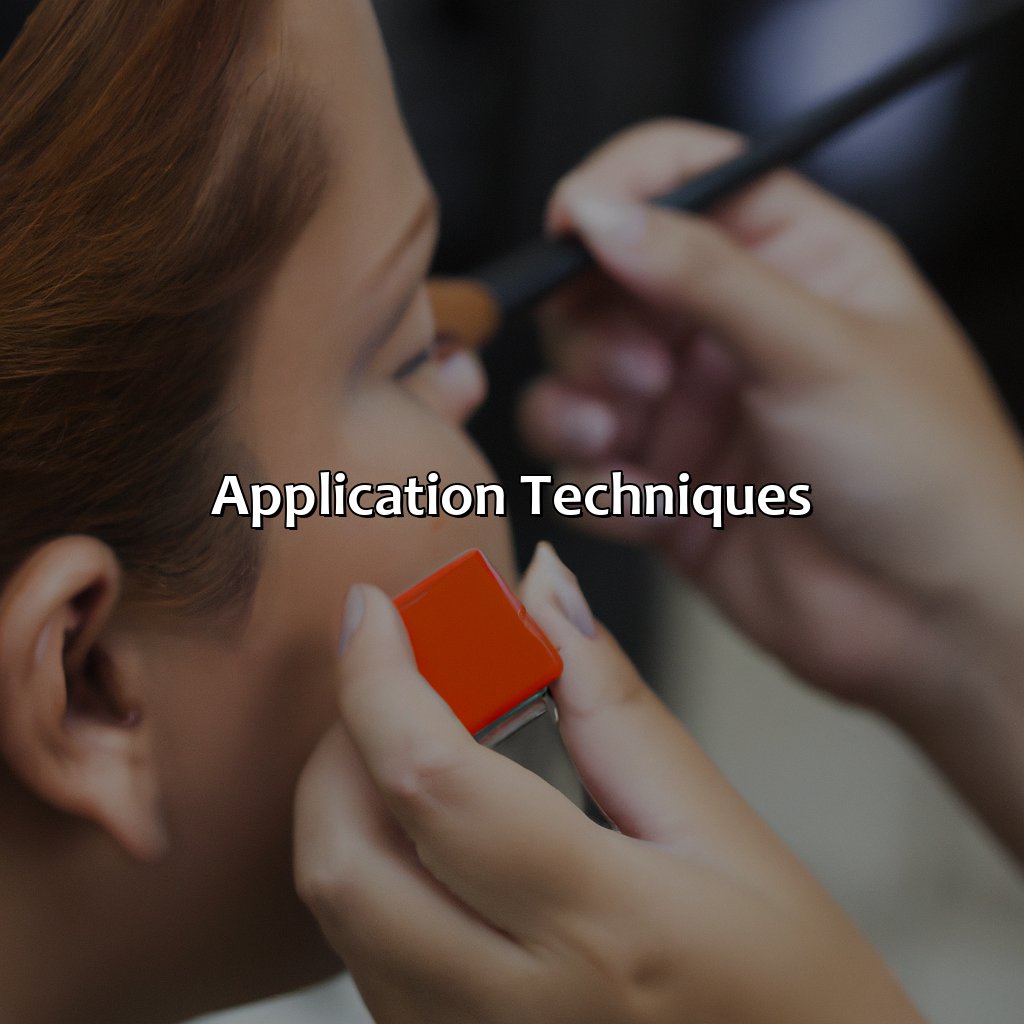
Photo Credits: colorscombo.com by Harold Brown
This section will guide you through “what color corrects dark circles.” It will help you perfect the way you apply makeup, like using concealer, color correcting palette, brush, sponge, or fingers to achieve your desired look.
- The Concealer sub-section will cover how to use concealers to handle under-eye bags and tired eyes.
- The Color Correcting Palette sub-section will explore how to use this palette for pigmentation and discoloration.
- The Brush, Sponge, or Fingers sub-section will look at the differences, benefits, and downsides of each of these application methods.
Concealer
Covering Up: How Makeup Can Conceal Dark Circles
Makeup, specifically concealer, is a popular choice to cover up dark circles. Applying color correction prior to concealer can enhance the outcome. The process begins with selecting the right shade of concealer that matches the skin tone, or one shade lighter. Using a small brush or fingers will help apply thinly and then build upon coverage depending on needs. Avoid tugging and pulling at delicate skin areas.
Using color correcting palette helps control the undertones of dark circles. For instance, tones like peach, orange, and pink work toward balancing out those with blue/purple undertones. Additionally blending with yellow, red or lavender can neutralize darker skin colors or even discoloration due to hyperpigmentation.
Our eyes reflect signs of tiredness through dark circles; consistent use of makeup alone may not be beneficial for long-lasting results. Incorporating hydrating skincare products like eye creams in a daily routine can contribute towards lessening under eye bags as well.
According to Elle Magazine’s Natalie Lukaitis: “Allergies are the most common cause of dark circles.” Lifestyle changes like managing stress levels and getting enough hours of sleep along with an improved diet plan including fluids (water intake) are known to contribute towards reducing dark eye circles.
Say goodbye to pigmentation and discoloration with the power of a color correcting palette – your makeup bag’s new secret weapon.
Color Correcting Palette
Color correcting palette is an essential tool in makeup for anyone dealing with pigmentation, discoloration, and under-eye dark circles. The color-correcting technique involves using different shades to neutralize the unwanted hues on the skin. This technique has become popular due to its effectiveness in creating a flawless base for any makeup look.
The following are some important points to consider:
- Color Correcting Palette: An efficient way of prepping your skin before makeup.
- Shades: Peach or orange tones are best for combating dark circles, green cancels out redness while lavender is great for reducing sallowness.
- Application Techniques: Apply the correct shade to neutralize the issue and blend out smoothly with a brush or sponge before proceeding with foundation.
- Blending: Blend the color correction in small circular motions until it disappears into your skin rather than sitting on top of it.
When compared to other types of concealer, color correcting palette is preferred as it can treat specific issues that traditional concealers might not be able to. Darker pigmentation spots tend to require stronger colors like red which cannot be found in most regular concealers.
It is important not only to use color correcting palettes but also follow a skincare routine that addresses underlying issues causing pigmentation and discoloration like dehydration. Incorporate hydration products and always use sunscreen. If possible, make lifestyle changes by managing stress levels through meditation or yoga and having a balanced diet rich in anti-inflammatory foods.
Don’t miss out on this magic tool for perfect skin! Try incorporating a good color correcting palette in your makeup bag today!
You don’t need a brush, sponge or even fingers to apply makeup – just use your mind to create the perfect beauty routine.
Brush, Sponge, or Fingers
Makeup Application Tools
When it comes to applying makeup, the tools you use can make all the difference in achieving a flawless finish. In the beauty community, there are several options for makeup application, including brushes, sponges, and using your fingers.
- Brushes: Makeup brushes come in various shapes and sizes, and each is designed to apply different types of products. For example, a flat concealer brush can be used to apply liquid or cream products under the eyes while a fluffy powder brush can be used to set face products.
- Sponges: Beauty sponges have grown increasingly popular as they help blend products seamlessly into the skin. They can be used for foundation application or to blot out excess product.
- Fingers: Using your fingers for makeup application may seem unhygienic but many people prefer this approach because of its convenience and accuracy.
Each tool provides unique benefits when it comes to makeup application. Choosing which one is right for you ultimately depends on personal preference.
Incorporating these tools into your beauty routine and experimenting with new makeup hacks can help elevate any makeup look. Taking inspiration from beauty influencers or following along with a makeup tutorial created by a makeup artist can also provide helpful insight into how these tools work best.
As for me, I struggled with finding my perfect tool until I discovered beauty sponges! They helped me apply my foundation effortlessly and gave me an airbrushed finish that I couldn’t achieve before.
Make sure to moisturize and protect those under-eye circles or they’ll be the only thing people see during your Zoom calls.
Skin Care Routine
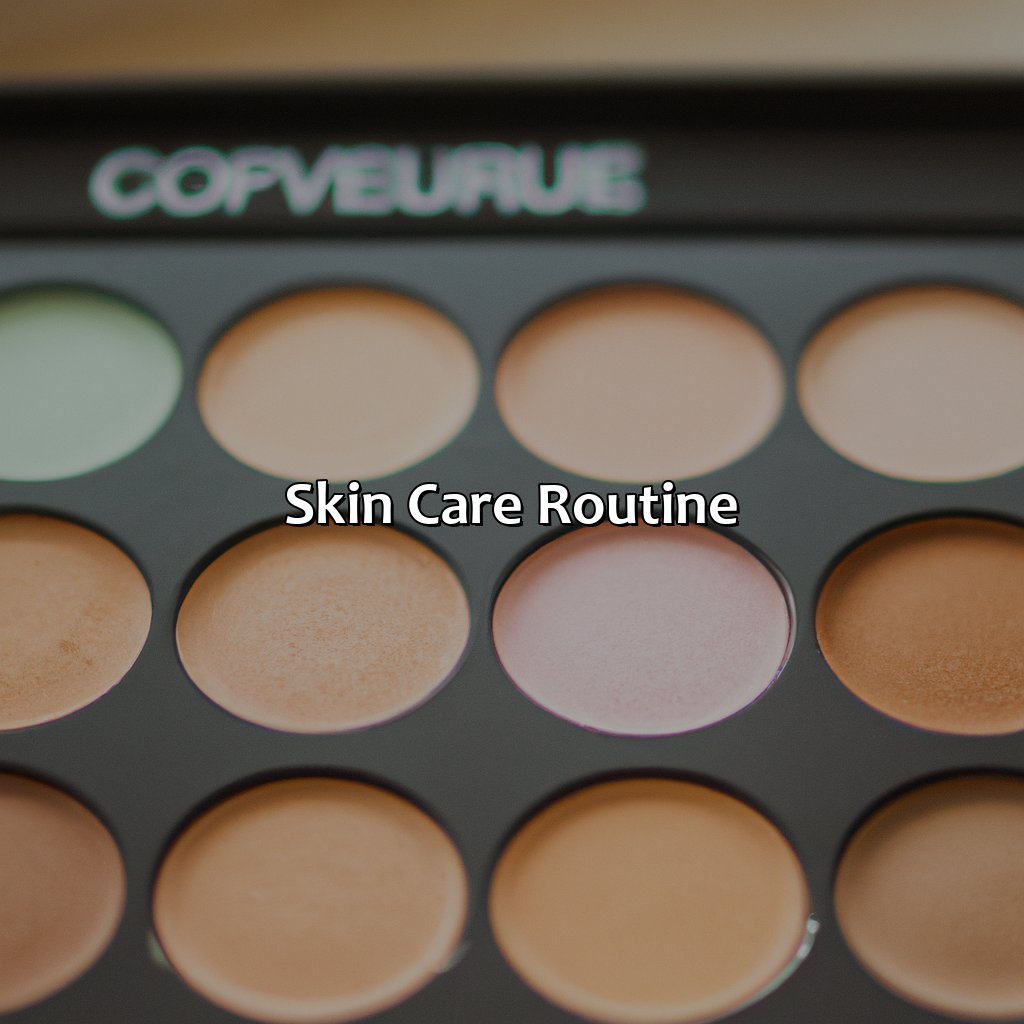
Photo Credits: colorscombo.com by Adam Baker
Strategize your beauty routine to enhance your skin care! For a healthy, bright complexion, use special products to address your needs. Let’s dive in and explore the three essential steps: Eye Cream Application, Hydrating Products, and Sunscreen. These can revolutionize your skincare and help target dark circles.
Eye Cream Application
Properly applying eye cream is an essential part of any skin care routine, particularly for those concerned with dark circles, under eye bags, and tired eyes. To get the most out of your eye cream, follow these six simple steps:
- Begin with a clean face and hands.
- Gently pat a small amount of cream around the entire orbital area.
- Avoid getting the product too close to your eyes – stick to the outer edges of the orbital bone.
- Use light pressure and your ring finger or pinky finger to avoid tugging on the delicate skin around the eyes.
- Avoid rubbing in circular motions as this can cause further irritation and puffiness.
- Wait several minutes before applying other products to allow the cream to fully absorb.
It’s important to note that excessive application of eye cream can potentially cause milia (small white bumps) around the eye area.
For best results, pair your eye cream application with hydrating products and sunscreen during the day. As these remedies take time to show improvements, it’s encouraged that one adopts a life-long dedication towards healthy lifestyles like proper sleep schedules, stress management techniques and having a balanced diet within reasonable amounts. Interestingly, experts say that proper skin hydration can improve different skin issues like wrinkles around mouth lines thus forming their missing youthfulness.
Historically used by ancient Egyptians over 6 centuries ago for beauty purposes.
A hydrated complexion is the foundation of any good beauty routine – just like how oxygen is the foundation of breathing.
Hydrating Products
Skin Hydration for Optimal Skin Health
To achieve radiant and youthful-looking skin, proper hydration is a crucial part of any beauty routine. Skin care products that provide deep hydration should be included in your daily regimen to maintain healthy skin.
Effective beauty products, such as moisturizers and serums, help to increase the water content within the skin cells, and they also assist in preventing water loss. These hydrating products contain essential ingredients that nourish your skin, leaving it soft, humidified, and refreshed.
Combining hydrating skincare products with a water-rich diet will keep your skin elastic and youthful-looking. Including leafy greens, fruits that are high in antioxidants (such as berries), Omega-3 fatty acids (like salmon), green tea rich in polyphenols will boost insulin sensitivity, enhance your blood sugar levels while supporting your immune system.
By prioritizing skin health as an integral part of one’s self-care routine with regular exercise and stress management techniques such as yoga or mediation practicing good sleep hygiene promotes cell renewal delaying pre-mature aging signs resulting in more hydrated plump looking youthful appearance.
Protect your skin from sun damage and dark circles with a daily dose of sunscreen.
Sunscreen
Protecting your skin from harmful UV rays is crucial for maintaining good skin health. Sunscreen is an essential component of any skincare routine, especially if you struggle with pigmentation or dark circles. It acts as a barrier against the sun’s rays and helps to prevent further damage to your skin.
Using sunscreen regularly can also slow down the aging process and reduce the appearance of fine lines and wrinkles. It is recommended to use a broad-spectrum sunscreen with at least SPF 30 every day, even on cloudy days.
To ensure maximum protection, make sure you apply it generously to all areas of exposed skin 20-30 minutes before going outside. Reapply every two hours if you are spending prolonged periods in the sun.
Incorporating sunscreen into your daily skincare routine is a simple yet effective way to improve your skin’s health and prevent further damage caused by UV rays. Don’t forget that prevention is always better than cure when it comes to protecting yourself from sun damage and reducing the appearance of dark circles.
Dark circles may make you look like a panda, but a healthy lifestyle can prevent you from living like one.
Lifestyle Changes

Photo Credits: colorscombo.com by Benjamin Harris
Want to look better? Change your lifestyle! Start with Diet, Sleep Schedule, and Stress Management. Eat nutritious food. Make a regular sleep schedule. Manage your stress. These small adjustments can give you beauty from within. Take care of yourself.
Diet
Eating for Beauty from Within
A healthy lifestyle is the key to beauty from within. Nourishing your body with nutritious foods helps reduce dark circles caused by unhealthy eating habits.
- Incorporate nutrient-rich, colorful fruits and vegetables into your daily diet.
- Include foods high in vitamins C and K, as well as iron and antioxidants.
- Stay hydrated by drinking plenty of water.
- Reduce alcohol and caffeine intake.
- Avoid processed and packaged foods.
Making these simple lifestyle changes will not only improve the appearance of dark circles but also promote overall health and nutrition.
A good sleep schedule isn’t just for beauty sleep, it’s also self-care for your under-eye circles.
Sleep Schedule
Maintaining a good sleep schedule is an essential part of self-care and beauty sleep. It not only helps in reducing dark circles but also improves overall skin health. Regularly getting 7-8 hours of quality sleep can decrease inflammation, increase blood flow and reduce stress levels resulting in healthier-looking skin.
To ensure a good sleep schedule, avoid consuming caffeine or alcohol before going to bed and try to stick to a consistent sleeping time. Create a relaxing atmosphere by dimming the lights and avoiding the use of electronic devices before bedtime. Establishing a pre-bedtime routine can also signal your body that it’s time for rest.
To further enhance the benefits of sleep on your skin, use silk pillowcases to prevent wrinkles and select products that aid nighttime skin repair such as hyaluronic acid or retinoids.
Pro Tip: Incorporate relaxation techniques such as meditation or deep breathing exercises to calm down your mind before bedtime for a better beauty sleep.
Stressful day? Remember, beauty from within starts with self-care and a good bottle of wine.
Stress Management
To maintain good overall health, it is important to focus on self care and relaxation techniques, as stress management plays a critical role in our lives. Engaging in activities such as yoga or meditation can reduce feelings of anxiety and stress. Additionally, practicing deep-breathing exercises and finding time to unwind can also help alleviate these symptoms.
Taking care of oneself also involves focusing on beauty from within. Ensuring you have a balanced diet and adequate hydration levels can significantly improve the appearance of dark circles. Eating foods high in antioxidants and healthy fats like salmon or avocados can greatly benefit the skin’s appearance.
Although stress management is essential, it is also beneficial to seek out professional treatments if necessary. This may include chemical peels, laser therapy, or fillers.
Finally, it is important to remember the dos and don’ts for proper skin care. Do use sunscreen daily, hydrate often with non-alcoholic and non-caffeinated drinks, apply eye cream regularly, and choose the correct color correcting palette suited for your skin tone. However, do not neglect sleep habits or engage in unhealthy dietary choices that could exacerbate dark circles.
In sum, prioritizing stress management and maintaining a self-care routine can help combat the appearance of dark circles. Creating an optimal lifestyle by incorporating relaxation techniques as well as beauty from within practices enhances one’s overall health and well-being.
From chemical peels to fillers, professional treatments can give your skin the beauty boost it deserves, making you a proud member of the beauty community.
Professional Treatments

Photo Credits: colorscombo.com by Randy Smith
Make your beauty routine on-point! Try professional treatments like chemical peels, laser therapy, and fillers to tackle dark circles. These treatments can give your skin a rejuvenated look and help improve your appearance. Here, we’ll explore the benefits of each treatment. We’ll also tell you about their key features and maintenance tips.
Chemical Peels
Chemical peels are a type of professional beauty treatment that can improve the appearance of dark circles. This treatment involves applying a chemical solution to the skin, which causes it to exfoliate and eventually peel off. The new, regenerated skin is usually smoother and less wrinkled than the old skin.
To improve the appearance of dark circles, a chemical peel can be applied under the eyes and around the eye area. The acids in the peel help to lighten areas of hyperpigmentation and reduce the appearance of fine lines and wrinkles. A series of chemical peels may be required to achieve optimal results.
It is important to note that not all individuals are good candidates for chemical peels, as certain skin types may be more susceptible to adverse reactions. It is recommended to discuss this option with a skincare professional before undergoing treatment.
In addition to getting professional treatments like chemical peels, incorporating skincare products into your daily routine can also be beneficial for reducing dark circles. Using an eye cream that contains ingredients like vitamin C or retinol can help brighten the under-eye area over time.
Don’t miss out on improving your dark circles with professional treatments such as chemical peels, along with incorporating skincare products into your daily routine.
Laser therapy: because sometimes the best way to get rid of dark circles is to zap them with a laser (sorry, cucumbers and tea bags).
Laser Therapy
Many seek professional treatments to diminish dark circles, and laser therapy is one such treatment. It uses a targeted beam of light to stimulate collagen production and brighten the under-eye area. This beauty treatment typically requires multiple sessions and comes with some downtime. Laser therapy should be done by a licensed professional to avoid any negative side effects. Incorporating laser therapy into your skincare routine can help improve the appearance of dark circles over time and give you radiant skin like never before.
Fillers: Because sometimes your skincare routine needs a little extra injection of beauty treatments to banish dark circles for good.
Fillers
Using dermal fillers is a popular way to diminish dark circles. They are injected into the undereye area to plump the hollowed-out skin and reduce the appearance of darkness. The results can last for several months, but touch-up sessions may be necessary.
Dermal fillers provide a non-invasive alternative to plastic surgery. They have been approved by the FDA and have a high safety profile when administered by a licensed professional. Fillers are generally made of hyaluronic acid, which occurs naturally in the body or other synthetic materials.
In addition to reducing dark circles, fillers can also treat fine lines, wrinkles, and scars. There are different types of fillers available, each with its own unique properties and benefits. Discussing this with a licensed professional is essential for choosing the best filler for your specific needs.
According to the American Society of Plastic Surgeons, in 2020, there were over 2 million injectable filler treatments performed in the US alone. (Source)
Beauty is pain, but it shouldn’t be dangerous – here are the dos and don’ts of your beauty routine, straight from the experts.
Dos and Don’ts
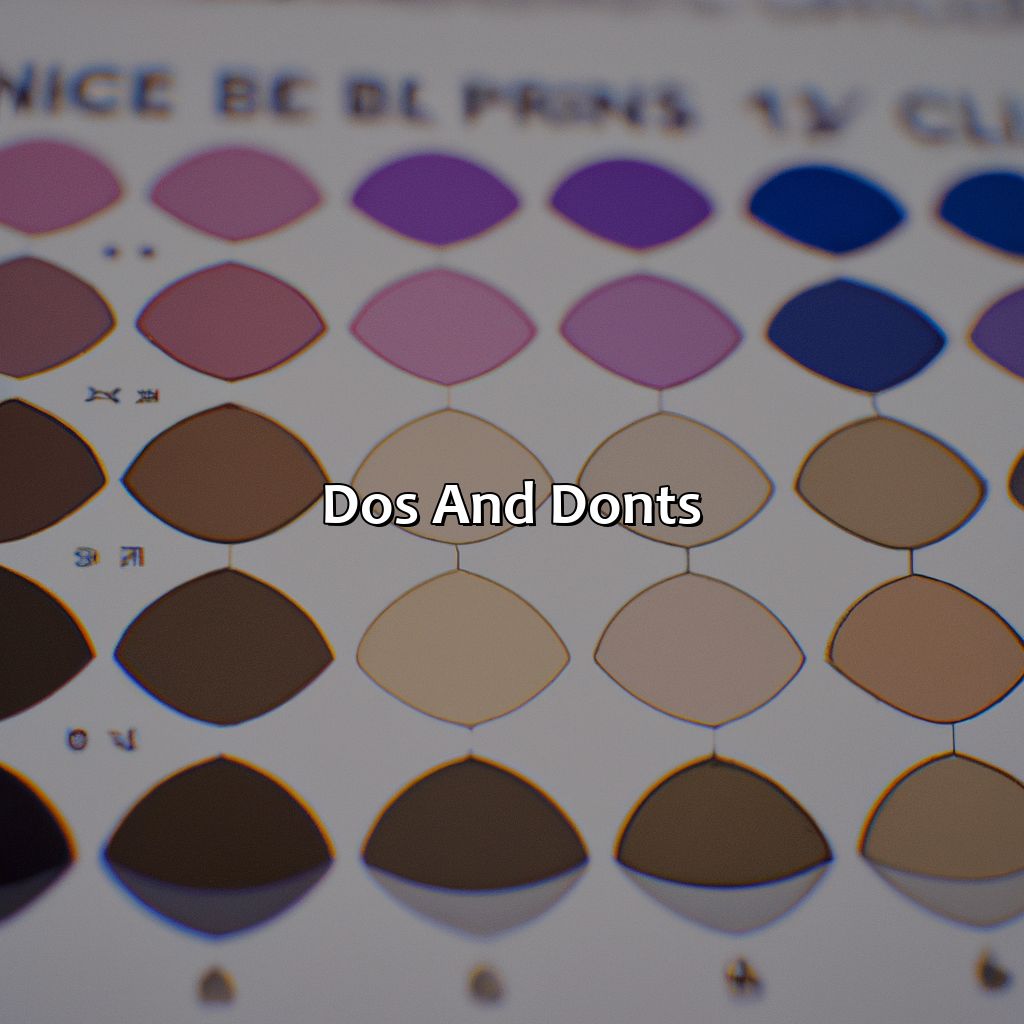
Photo Credits: colorscombo.com by George Wright
For a perfect beauty look, you must know the right moves. Our article will show you the Do’s and Don’ts when it comes to skincare, products, makeup and more. We have the perfect guide to help you in the tricky world of beauty.
Here are some tips and tricks for flawless beauty hacks. Discover what color corrects dark circles – the Do’s and Don’ts of beauty!
Dos
To achieve the desired results and avoid harm, implementing beauty tips, as well as following a skincare beauty routine, is essential in treating dark circles. Always start with assessing your skin type before purchasing any beauty products or makeup hacks. Use color-correcting palettes or concealers based on your skin tone and type. For application techniques, use brushes, sponges, or fingers while applying concealer or the product. Apply eye cream to hydrate skin and use sunscreen to protect it from UV rays.
Additionally, maintain good sleeping habits and reduce stress levels by practicing yoga or meditation. Eating a well-rounded diet will also help prevent dark circles, such as adding leafy greens, berries rich in antioxidants like Vitamin C. In terms of professional treatments for dark circles then consider fillers such as chemical peels and those involving laser therapy.
Overall it’s important to follow these dos & don’ts so that the required beauty tips can be utilized without causing damage to one’s skin-health:
- Do choose color-correcting shades under peach tones for warm undertones or pink tones for cool undertones;
- Do hydrate sensitive areas beneath eyes regularly;
- Don’t skip using adequate sunscreen before using any products containing retinoids/retinols;
- Don’t rub the fragrance-based creams infused with scents since it can irritate the sensitive region around the eyes.
Don’ts
To ensure the effectiveness of correcting dark circles, it is essential to understand the Don’ts in this beauty routine. Improper use or lack of knowledge can often worsen the problem.
- Using a Concealer that doesn’t match your skin tone: This mismatch will result in highlighting rather than concealing the dark circles.
- Applying too much product: This approach can make you look cakey and highlight fine lines and creases around your eyes.
- Sleeping with makeup on: Not removing makeup before bed can block pores and cause inflammation and puffiness.
When using color correctors or concealers, it’s crucial to blend them well into the skin to create a natural effect.
Pro Tip: Opting for lightweight products with hydrating formulas will prevent creating visible layers of color correcting and concealing products. These can weigh down the sensitive skin around the eye area, causing irritation and puffiness.
Five Facts About What Color Corrects Dark Circles:
- ✅ Peach or orange-colored corrector is best for correcting bluish or purple dark circles. (Source: Elle)
- ✅ Green corrector can neutralize redness and is useful for people with fair to medium skin tones. (Source: Byrdie)
- ✅ Yellow corrector can help to brighten under-eye areas for people with medium to dark skin tones. (Source: InStyle)
- ✅ Lavender corrector can help to neutralize yellow tones and is best suited for people with fair to medium skin tones. (Source: Cosmopolitan)
- ✅ Color correctors should be applied under your foundation or concealer for the best results. (Source: Harper’s Bazaar)
FAQs about What Color Corrects Dark Circles
What color corrects dark circles?
The color that corrects dark circles is peach or salmon tones, which help to neutralize the blue or purple undertones of the dark circles.
Can I use green color corrector for dark circles?
No, using a green color corrector for dark circles is not recommended as it is meant to neutralize redness, not blue or purple undertones.
What other colors can I use to correct dark circles?
Aside from peach and salmon tones, you can also use yellow or gold tones to brighten up dark circles. However, it is important to match the correct tone to your skin type and undertone for best results.
Should I apply color corrector before or after concealer?
Color corrector should be applied before concealer, as it helps to neutralize and brighten up the skin before makeup application. This will also help to use less concealer, as the color corrector will already have done some of the work.
Can I use a full-coverage concealer instead of color corrector?
While full-coverage concealer can help to cover up dark circles, it is not as effective as using a color corrector as it does not neutralize the undertones of the dark circles. Using a color corrector first can help to achieve a more natural and seamless look.
Do I need to use a color corrector every time I apply makeup?
No, using a color corrector is optional and depends on your own preference and the severity of your dark circles. If you have very pronounced dark circles, using a color corrector can make a big difference in achieving a brighter and more even complexion.
